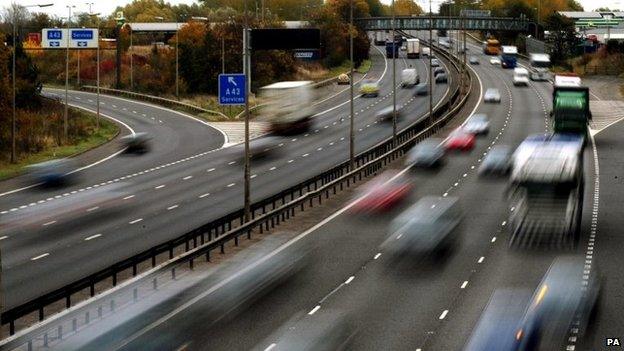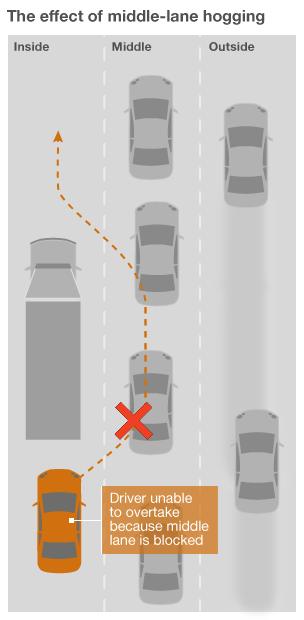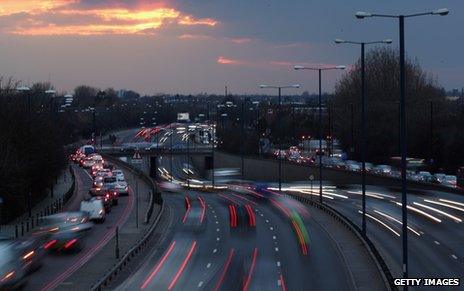Who, what, why: What's wrong with middle-lane hogging?
- Published

People who "hog" the middle lane on the motorway could now be fined £100 and given points on their licence. But why is staying in the middle lane a bad thing?
Middle-lane "hogging" has gone on for years. It's common to see a situation where the left-hand lane is relatively empty but cars are still sitting in the middle lane instead of just using it for overtaking.
Part 264 of the Highway Code says: "You should always drive in the left-hand lane when the road ahead is clear. If you are overtaking a number of slower-moving vehicles, you should return to the left-hand lane as soon as you are safely past."
The Highways Agency tried signs in 2004 urging people to keep left, external but the problem has not been solved.
With "undertaking" [overtaking to the left of a car] frowned upon in the UK, middle-lane driving can annoy many people.
Now the government has outlined its latest attempt, external to tackle this seemingly perennial problem. People who hog the middle lane will be subject to spot fines of £100 and points on their licence.
But what are middle-lane drivers actually doing wrong?
AA president Edmund King says there's a very simple reason why lane-hogging is wrong. "It causes congestion."
He says that lane-hogging wastes a third of motorway capacity, probably a reference to research by the RAC Foundation, external.
It means that the slowest, inside lane is under-used and the remaining traffic is bunched up into the middle and outside lanes.

"It's a particular problem where we've widened motorways to four lanes because the middle lane hoggers can take up two lanes."
But the extent to which lane hoggers cause congestion is controversial. Benjamin Heydecker, professor of transport studies at University College London, has looked at the impact of hoggers on congestion. "We expected to find a big reduction in capacity. But the answer was surprisingly small."
People who say that middle-lane hoggers cut carrying capacity by a third are wrong, he says.
It may be that they're looking at a three-lane motorway and assuming that the middle lane is out of action. That would be true if the lane hoggers were stationary. But they are still moving relatively fast.
"They [the hoggers] are moving, so if the traffic is concentrating behind them you still have flow."
The lane hoggers do affect the carrying capacity of a road because they are forcing people behind to change lanes, he says. "But it is certainly not a one third reduction in capacity," he says.
Ronghui Liu, tutor at the Institute for Transport Studies believes it depends on the level of traffic. At high flow (very busy) level you want traffic spread evenly between the lanes.
This is how the M25 operates much of the time with traffic following a variable speed limit of, say, 60mph. There is no moving between lanes and the maximum amount of traffic fits on to the road, moving in line with the variable speed limit.
But on moderately busy motorways lane hogging might be a problem, she argues. People who would have the opportunity to overtake cannot do so.
There are cultural differences. In France anyone dawdling in the overtaking lane will soon be flashed or tailgated. Neither is lane-hogging common in Germany, says Liu.
"Lane-hogging is just not seen on German autobahn, which functions very well without a mandatory speed limit and with fewer lanes, often just two."
Congestion is not the only factor. Lane hogging makes other drivers angry and forces them to weave in and out of the traffic, says motoring journalist Quentin Willson.

"You take umbrage because you know they're muppets who don't understand how the motorway works," Willson says. There is a "grammar" to driving on the motorway. You stay left, overtake where necessary and then move into the left-hand lane. That's what the Highway Code says - it's a way of allowing the traffic to travel at the optimum speed.
"If they don't know that there's going to be lots of other things they don't know about motorways," Willson says. "You feel they don't have the right to travel on this road."
The issue comes down to safety, Heydecker says. While he doesn't accept that lane hoggers significantly reduce motorway capacity, they do raise drivers' blood pressure by their behaviour.
"It's dog in a manger. The lane hogger is not doing themselves much good but they're also preventing the people following them from doing what they want to do. The issue is inconsiderate, selfish behaviour."
Francis Wheen once described middle Englanders as people who would "'happily drive the full length of the M4 in the middle lane, while listening to Andrew Lloyd Webber's Requiem".
King says lane hoggers tend to be older people who are unaware of the other traffic. "The other day I came across a little old man sitting very close to the steering wheel. He was doing 49 mph in the middle lane. All the traffic coming up behind was doing 75mph so it was very dangerous."
Researchers at the Institute of Psychological Science at the University of Leeds noted that older drivers have, external a "built-in safety mechanism" which inclines them to drive in the middle of the road to avoid manoeuvres which could test their gradually slowing reactions.
Some have argued for copying the example of California where drivers are encouraged to stay in lane, but are allowed to pass vehicles on either side where necessary.
Heydecker says the Californian example would be ideal for increasing the carrying capacity of the UK's roads. "If this was just a capacity issue we'd say allow passing on both sides." But there is also an argument about safety.
Motorways are currently the safest roads in the UK, Heydecker says. Any change to the system of driving would need to keep them as safe as they are now. "The big question in the UK is whether we'd allow passing on both sides. I believe the Department for Transport is resistant to this."
You can follow the Magazine on Twitter, external and on Facebook, external
Here is a selection of comments from the Magazine Facebook page
Erm, could I say, as an HGV driver stuck at 53/55mph, these people are a real problem for us.
Nick Ingram
If you are doing 70 mph why should you not be able to stay in middle lane if traffic on inner lane is going slower? I think it is dangerous to keep swapping lanes. The only people who would object are those who want to be in the position you are in. If they are going any faster, they are breaking the speed limit. So why shouldn't we stay in that lane? If driving at a slower speed then yes, stay in the inside lane. Also if everyone is sitting in the inside lane, traffic feeding onto the motorway cannot get onto it easily and it is more considerate to get in the middle lane to allow traffic to feed in safely. If I were to be fined for driving along the middle lane at 70 mph I would raise serious objections that the reason is because it was preventing someone from overtaking me faster than the speed limit allows. How can that be right?
Linda Goulding
People are missing the point and the diagram doesn't really demonstrate the problem. The issue is where people sit in the middle lane at 70mph or below when the next vehicle in the inside lane in 200 yards away. What this then does in reality is reduce the motorway to two lanes and thus causes congestion, sudden breaking and frustration.
Matt Thompson
Good idea in principle, poor in practice. The bigger problem is presented by the outside lane, and there are major problems with outside lane hogs. In my experience, if the middle lane is full as shown by this diagram, it's because they are actually overtaking the lorry. The inside lane is usually absolutely chock-a-block with freight traffic, which in practice means that staying on the inside lane for any significant length of time is impractical unless you wish to indefinitely be doing 40mph and stuck behind an HGV. It is indeed frustrating when everyone is overtaking you in the middle lane, and I would agree that it is simple good manners to let someone in who might be stuck behind a lorry, but staying in the middle lane to overtake a never-ending convoy of freight traffic is preferable to - and safer than - weaving in and out constantly to avoid it.
Darryl LeCount
Foresee an increase in side swipes, cars moving into the middle lane from the third lane being hit by cars moving out to overtake from the first lane that are blind to the wider angle of approach of the vehicle from the third lane.
Thomas Stocks
At £100 a go, I'd employ 20 cops to sit on consecutive bridges giving them out. We should be able to clear the chancellor's problems in under a week with the pathetic driving in the UK.
Kristian Yates
Surely moving left into a 200m gap then moving right again after about 60m (in order to leave the appropriate 2 second, 70m spacing both sides) is far more dangerous, and leads to far more lane changing than sitting in the middle lane at 70. By definition you can't be holding up any law abiding citizens so what is the problem? Why should I make my and other people's life more dangerous to make it easier for others to break the law? Should we leave our houses unlocked so as not to inconvenience burglars?
Dave Ansell
Perhaps teaching people how to actually drive on a motorway as part of their DRIVING LESSONS might actually help! Instead we just let new drivers out with no practice and no wonder they just stick to the middle lane thinking they are not bothering anyone!
Emma West